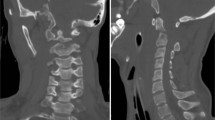Abstract
Introduction
The horizontal synchondroses of the infant axis are biomechanical weak regions in trauma.
Case
We report the case of a 6-year-old girl who presented with delayed atlantoaxial dislocation and displaced ossiculum terminale epiphysiolysis after a fall from a tree.
Treatment
The patient was treated with halo traction for 3 days after which a CT scan showed normal position of the C1/C2 joint, and an acceptable position of the ossiculum terminale whereafter a halo brace was applied. Because of delayed union on CT scans, the treatment was prolonged to a total of 21 weeks.
Result
At final follow-up 26 months after halo brace removal, the patient demonstrated normal range of movement of the neck on clinical examination and radiographs of the cervical spine including lateral flexion/extension radiographs showed no sign of instability of the atlantoaxial joint.
Discussion
Conservative treatment with a halo device versus surgical treatment is discussed.







Similar content being viewed by others
References
Bailey DK (1952) The normal cervical spine in infants and children. Radiology 59(5):712–719
Blauth M, Schmidt U, Krettek C (1996) Fractures of the odontoid process in small children: biomechanical analysis and report of three cases. Eur Spine J 5:63–70
Odent T, Langlais J, et al. (1999) Fractures of the odontoid process: a report of 15 cases in children younger than 6 years. J Pediatr Orthop 19:51–54
Fassett DR, McCall T, Brockmeyer DL (2006) Odontoid synchondrosis fractures in children. Neurosurg Focus 20:E7
Wada E, Takashi M, Kawai H (2009) Os odontoideum as a consequence of a posttraumatic displaced ossiculum terminale. J Bone Joint Surg Am 91:1750–1754
Viswanathan A, Whitehead WE, Luerssen TG, et al. (2009) “Orthotopic” ossiculum terminale persistens and atlantoaxial instability in a child less than 12 years of age: a case report and review of the literature. Cases J 2:8530
Fielding W, Hensinger RN, Hawkins RJ (1980) Os odontoideum. J Bone Joint Surg 62:376–383
Kirlew KA, Hathout GM, Reiter SD, Gold RH (1993) Os odontoideum in identical twins: perspectives on etiology. Skelet Radiol 22:525–527
Fagan AB, Askin GN, Earwaker JWS (2004) The jigsaw sign. A reliable indicator of congenital aetiology in os odontoideum. Eur Spine J 13:295–300
Sankar WN, Wills BPD, Dormans JP, Drummond DS (2006) Os odontoideum revisited: the case for a multifactorial etiology. Spine 31:979–984
McHugh BJ, Grant RA, Zupon AB, DiLuna ML (2012) Congenital os odontoideum arising from the secondary ossification center without prior fracture. J Neurosurg: Spine 17:594–597
Swoboda B, Hirschfelder H, Hohmann D (1995) Atlantoaxial instability in a 7-year-old boy associated with traumatic disrupture of the ossiculum terminale (apical odontoid epiphysis). Eur Spine J 4:248–251
Weißkopf M, Naeve D, Ruf M, Harms J, Jeszenszky D (2005) Therapeutic options and results following fixed atlantoaxial rotatory dislocations. Eur Spine J 14:61–68
Fulkerson H, Hwang SW, Patel AJ, Jea A (2012) Open reduction and internal fixation for angulated, unstable odontoid synchondrosis fractures in children: a safe alternative to halo fixation? J Neurosurg Pediatrics 9:35–41
Acknowledgments
We would like to thank Karl Erik Jensen, MD, DMSc, Department of Radiology, Rigshospitalet-Blegdamsvej, Copenhagen University Hospital, Blegdamsvej 9, 2100, Copenhagen.
Author information
Authors and Affiliations
Corresponding author
Ethics declarations
Conflict of interest
Jonas Walbom and Anders Kruse state that there are no conflicts of interest.
Rights and permissions
About this article
Cite this article
Walbom, J., Kruse, A. Traumatic atlantoaxial rotatory dislocation and displaced ossiculum terminale epiphysiolysis treated with a halo device: a case report. Childs Nerv Syst 32, 1321–1325 (2016). https://doi.org/10.1007/s00381-016-3025-2
Received:
Accepted:
Published:
Issue Date:
DOI: https://doi.org/10.1007/s00381-016-3025-2




